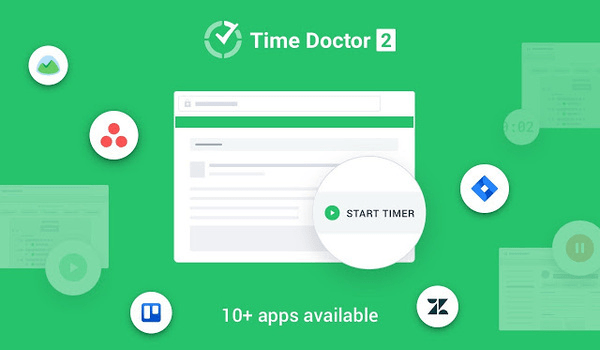Wondering how to increase productivity in the workplace?
A successful business owner understands how important productivity is in a work environment.
Employee productivity can help companies use the capacity of their available workforce efficiently. And most enterprises that focus on productivity usually have healthy and happy employees, which adds to their overall success.
However, trying to use a single approach for every employee will most likely fail because one might not easily understand everything. Knowing which method to use for each employee would offer a better solution and can create a happy and healthy environment for both the employee and the company — making it easier for employees to achieve their goals.
In this article, we’ll take a look at 15 practical tips for increasing workplace productivity.
This article contains:
(Click on the links to jump to a specific section)
- How To Increase Productivity In The Workplace
- Keep Employees Accountable
- Motivate Your Employees
- Conduct Regular Reviews
- Avoid Micromanaging
- Assign Realistic Tasks
- Be Strict With Breaks
- Encourage Exercising
- Break Job Routines
- Always Set The Bar High
- Provide Training
- Avoid Multitasking
- Remove Distractions
- Let Employees Decorate Their Office
- Reward Employees With Great Perks
- Use Productivity Software
Let’s get started.
How to increase productivity in the workplace
Here are 15 tips for increasing productivity in the workplace:
1. Keep employees accountable

When you’re giving orders to your employees, always be precise and avoid giving general orders.
You should also designate the task to each assigned individual and ensure that they fully understand that they’re the ones responsible for their duties.
Holding your employees accountable for their tasks and goals means that they’ll put in extra effort and be more meticulous with their tasks.
How?
Having them feel that they’re held accountable would strengthen their sense of ownership of the kind of work handed to them. So with this sort of mindset, they tend to achieve it as best as they could.
This process is also another way to ensure that fewer mistakes are made.
2. Motivate your employees

Employee motivation is an essential factor in improving workforce productivity.
Why?
Employees lacking motivation get bored quickly, especially those employees that do routine tasks every single work day.
Another issue is that unmotivated employees don’t have any joy in finishing any tasks handed to them.
So how do you motivate your employees?
One effective way to raise an employee’s motivation is through gamification.
As the word gamification suggests, make something enjoyable out of the task handed to them.
Like how RPGs (role-playing games) use repetitive elements like boosts, rewards, life powers, and rankings to level up, your employees need something that’ll motivate them to achieve more, such as:
- Being the week’s top sales leader.
- Having the highest attendance percentage.
- Completing the most tasks in a month, etc.
This kind of “game” environment also boosts employee morale and employee motivation.
With this type of process, employees are motivated to work hard and work more efficiently because they can earn something from it.
Many companies usually forget to recognize a job well done or even thank the employees for working hard, which can result in a negative impact and unmotivated employees.
Employees might think that their efforts aren’t’ recognized, so they stick to doing mediocre work, which leads them to boredom.
A word of encouragement, a simple thank you, and little rewards for working hard will show how much the management and the company value their jobs. It may also be possible to convert rewards, points, and rankings to monetary bonuses.
But always remember that rewards can come in many forms, such as mandatory leave or time off from work.
This will keep them motivated and engaged because they’re both recognized and valued for doing their best for the company.
Looking for more ways to boost employee engagement?
Here are the best employee engagement software.
3. Conduct regular reviews

One way to create a productive and engaged employee is to explain what’s expected of them.
This is the main reason why companies introduce employees to their company’s vision, core values, and company culture during the onboarding process.
However, always be mindful of how you delegate tasks, and don’t forget to follow up with each employee about their assigned task.
Remember to ask for the status of the task given to them. This way, you’ll know that progress is being made and your employees are doing their work.
It’s also important to provide feedback after they give you an update.
Why?
Feedback is one way to ensure that the employees aren’t stuck with whatever ideas they have.
Additionally, employees like to hear feedback from their employers because it lets them know what parts of the task need tweaking, what’s lacking, and anything else they need to change.
You should also acknowledge their accomplishments but also address their errors and faults while providing them with solutions.
The key is to give constructive criticism of their performance.
4. Avoid micromanaging

It might be difficult to determine the difference between micromanaging and managing.
However, always keep in mind that with micromanaging, you’re teaching your employees to become dependent on you or their supervisors.
Employees need direction and should have initiative while doing their jobs.
But spoon-feeding every detail of their job can hinder an employee’s growth.
Project managers are responsible for assigning tasks, defining duties, and providing employees with the resources they need to complete their work. However, it’s the employee’s responsibility to figure out how they should go about their tasks.
To avoid micromanaging, encourage employees to work the way they want.
Ask them to learn, work, and think independently, benefiting the company.
And if they make any mistakes, always speak to them first before jumping to any conclusions. This way, your employees will try their best to avoid making the same mistakes in the future.
5. Assign realistic tasks

Pushing your productive employees to the limit of their ability is fine, but do not overdo it.
Employees are humans, and humans get tired.
Some employees may feel completely overloaded with their never-ending task list.
Being overburdened by tons of daily tasks may be why employees are procrastinating. This can lead to frequent delays and unproductiveness.
Employers need to assign achievable tasks and give employees enough time to do those tasks. This way, employees will feel motivated because they’re accomplishing all the tasks you’ve provided to them.
Burning them out with a crazy job and unachievable deadlines are major motivation killers.
So what can you do?
Set realistic individual goals and targets for your employees. This way, you can increase their effectiveness, awareness, and impact on their role in your company.
6. Be strict with breaks

Encourage employees to have breaks and other recreational activities.
Why?
Stress from overworking can lead to two things:
- It can demotivate the employee.
- It can also lead to procrastination, which is a major productivity killer.
Taking breaks from work can help reset your employee’s tired brains.
We suggest a 10-minute break after 50 minutes of work.
A short break can help you feel refreshed when you need to start a new task or work on the current task.
You should also ask them to take a 30-minute break every 3 hours.
And remember to encourage your employees to have a change of scenery during that break.
They can use this time to go out for a walk, grab a coffee, or plan their weekly grocery list.
7. Encourage exercising

Your employee’s health should be your top priority. Your business can’t be successful when your workforce is often sick or absent.
Sitting down in front of a computer all day can pose major health risks.
Some ideas that can prevent employees from being ill or stressed are:
- Encourage employees to stand up for a few minutes every day.
- Add standing desks to the office.
- Allow employees an opportunity to do some remote work to avoid the stresses of commuting.
- Opt for a weekly yoga / Zumba/ aerobics session after work hours.
The bottom line is you should encourage employees to have a physical fitness schedule in their daily activities.
It could be stretching, a little workout or maybe some home done aerobics exercise or even an athletic team building exercise, which also improves worker engagement.
Another benefit of this is that team building activities could also lead to better teamwork in your workplace.
This kind of activity will not only keep them fit and healthy but also boosts employee engagement and helps employees have a clearer mind, especially when working.
It’s proven that employees who are physically fit and mentally active will perform better at work and have a positive attitude towards work and its workplace.
8. Break job routines

While it’s good to allow an employee to focus on a particular core task, doing that same job for about 40 hours can become exhausting.
To break this dull job routine, try rotating the responsibilities and introducing new roles to different employees.
This way, you can expand their abilities and can give your team an overview of the type of roles their co-workers have. They’ll also gain insights into how the company works.
9. Always set the bar high

Different organizations have their standards, and it’s essential to introduce employees to those expectations for long-term success.
Let your employees know the rules your business is imposing and what you expect from them.
Your employees also need to know that they’ll get more promotion opportunities by developing new skills or acquiring new knowledge.
Every work day should be a challenge for each employee.
Your employees should not be complacent and just stick to manageable tasks. This would reduce their value, and consequently, affect work productivity.
So you should let your employees understand that trust, opportunities, and respect are something that everyone should earn.
10. Provide training

Just like how we update our technologies, your employees need an upgrade as well — this will help them reach a higher level of productivity.
Learning is a continuous process, and providing your employees with seminars and training courses will improve their skill sets.
Introducing your employees to innovative solutions will also motivate them to be more creative while they work. Always remember, a motivated employee is a happy employee.
But it doesn’t mean that you need to spend a considerable amount of money just to give them the necessary training. You can always hire a speaker or trainer that would like to teach or motivate your employees.
11. Avoid multitasking

We know this sounds strange.
Usually multitasking is considered a skill and helps employees reach targets quickly.
Nowadays, there are tons of productivity tools out there that can streamline daily tasks for you.
So there’s no need to encourage your employees to multitask when they actually have the time to focus on a specific task.
Although multitasking can lead to short-term achievements, working on many tasks every day can also lead to burnout.
Once employees are burnt out, they’ll struggle to concentrate, which can lead to several mistakes on projects.
12. Remove distractions

Letting your employees have access to their mobile phones at all times can be a bit of a time waster.
We don’t mean that you should initiate a cell phone ban.
However, creating a cell phone policy that encourages employees to turn off their phones while they work can lead to increased productivity.
It’s also important to give them the time to check for any messages, so they’re not distracted by the thought of incoming messages, their social media, or phone calls.
While a remote worker has the benefit of being able to work in a quiet home, an in-office employee can get distracted by casual conversations and background noise.
So how can you prevent distractions at the workplace?
Here are a few solutions:
- Ask employees to speak softly when taking phone calls.
- Encourage employees to use headphones to listen to music or podcasts to block out the noise.
- Cut down the number of unnecessary meetings at the workplace.
13. Let employees decorate their office

A study conducted by Tim Harford shows that employees are 30% more productive when they’re allowed to decorate their offices.
This means that the more comfortable your employees feel, the less stressed and more productive they’ll be. It also boosts morale and leads to a more productive workplace.
Additionally, your employees will look forward to seeing and working in a well-decorated office environment.
14. Reward employees with great perks

This one is all about employee satisfaction.
What do we mean?
Well, let’s take a look at Google.
Google is well-known for providing employees with massage rooms, nap pods, and complimentary haircuts.
The point here is to offer your employees some perks, so they have a better employee experience and feel comfortable in their work environment.
According to the Fellowes Workplace Wellness Trend Report, 87% of employees would like their current employer to offer healthier workplace benefits like wellness rooms, company fitness benefits, healthy lunch options, and ergonomic seating.
Here are some other examples of perks you can introduce to improve employee job satisfaction:
- Bookstore vouchers.
- Spa day passes.
- Monthly movie tickets.
- Gym memberships.
15. Use productivity software

Productivity software helps people get more done at work through features like time trackers, reminders, reports, and checklists, along with automated invoicing software meant to streamline payment processes.
On top of that, productivity software also offers project managers a visual representation of the organization’s workflow, which improves task delegation and team coordination.
A. Know the new applications in the store
There’s a new app sold in the market or even downloaded for free each day.
Apps like language tutorials, to-do lists applications, and even apps where you can check and jot down your expenses are available today.
With the various types of iOS, Android, and Windows apps in the market, do some research and find an app that fits your business. After that, try to suggest it to your employees.
You can also look for browser extensions designed to help boost employee productivity.
B. Install and use an instant messenger
You should install an instant messaging software app to your employee’s stations for effective communication.
A group messenger app like Slack where you can quickly give instructions or feedback can be an excellent tool for improving communication.
Sharing information quickly through an instant messaging app is incredibly useful for large companies and companies that focus on remote work.
C. Install a time tracker
It’s important to be aware of how your employees use their time.
To do this, you need a tool that can track the amount of time your employees take to complete individual tasks and larger projects in real time.
This type of metric shows which employees are productive and which ones need more training.
Additionally, a time tracker tool also shows you which areas of your workflow are taking up the most time. And by using this info, you can implement a strategy to help your employees take less time on those tasks.
A well-rounded time tracking tool like Time Doctor not only tracks time spent on tasks but also an employee’s idle time.
What is Time Doctor?

Time Doctor is the ultimate time tracking and productivity management tool.
Used by incredibly productive companies and small businesses, Time Doctor is suitable for any business that wants to get more done.
With features ranging from advanced time tracking to excellent integrations with leading project management tools like Jira, Time Doctor is the best app for increasing employee productivity.
Here’s a quick overview of how Time Doctor can help you with time management:
- Track how much time it takes for teams to complete tasks.
- Create projects and assign tasks to team members right within Time Doctor.
- Use productivity ratings to select which websites and apps you want to be classified as unproductive.
- Access comprehensive work productivity reports so you can gauge each employee’s productivity level.
- Take screenshots of your employees’ computer screens during work hours.
- Track time on the go with the Android app.
Final thoughts
Boosting workplace productivity can be a challenging task.
But don’t worry!
Just implement the productivity tips we covered above and your employees will have the right resources to be super productive.
And remember, a healthy and happy environment is the key to higher productivity in the workplace.
About the Author

Susan Culp is a blogger specializing in business articles. She writes on behalf of Moneybanker, a company that provides the best options when it comes to loans. Aside from being a blogger and writer by heart, she also loves discovering innovative ways in improving one’s leadership and management skills.


